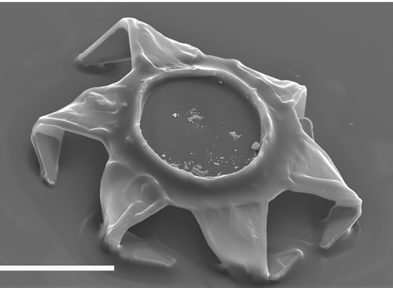Inspired by a parasitic worm that bites its host’s intestines, engineers have developed a device that could revolutionise slow release medicine delivery.
It’s about the size of a speck of dust, but the new technology, developed at Johns Hopkins University in the United States, could make a big difference to how slow release drugs are administered.
The ‘theragripper’ was created by Professor David Gracias from the Whiting School of Engineering and gastroenterologist Florin M. Selaru, Director of the Johns Hopkins Inflammatory Bowel Disease Center, along with a team of other researchers and biomedical engineers.
An unusual source of inspiration
The theragripper’s star-like shape was inspired by parasites (specifically hookworms) that use their sharp teeth to latch on to a host’s intestines. The microdevice is made of metal and a thin, shape-changing film, and then coated in heat-sensitive paraffin wax.

The hinges on the arms of the device are residually stressed. Once it reaches a certain temperature within the body, the paraffin wax on the hinges softens, causing the device to close in on itself and clamp onto the colonic wall.
“Normal constriction and relaxation of GI [gastrointestinal] tract muscles make it impossible for extended-release drugs to stay in the intestine long enough for the patient to receive the full dose,” Selaru said.
“We’ve been working to solve this problem by designing these small drug carriers that can autonomously latch onto the intestinal mucosa and keep the drug load inside the GI tract for a desired duration of time.”
While attached to the colon the theragripper can release medication gradually into the body. Eventually the device loses its grip on the tissue and passes through the body via normal gastrointestinal muscular function.
Small device, big potential
According to Gracias, the theragripper is roughly a quarter of a millimetre, or 250 μm, in size, which allows for efficient manufacturing — about 6000 theragrippers can be fabricated on a single silicon wafer — but also means the researchers couldn’t attach any kind of electrical devices to them.
“We have seen the introduction of dynamic, microfabricated smart devices that can be controlled by electrical or chemical signals, but these grippers are so small that batteries, antennas and other components will not fit on them,” he said.
“Instead, they operate like small, compressed springs with a temperature-triggered coating on the devices that releases the stored energy autonomously at body temperature.”
While the current version is triggered by temperature, Gracias told the BBC’s Science Focus that he believes future versions of the device could be triggered by things such as pH or biomolecules. This means the theragripper could be targeted to cling to specific parts of the gastrointestinal tract, such as the small intestine or oesophagus.
The team has already successfully tested the device on animals. According to their paper, published in Science Advances, the pain killer they trialled stayed in the test subjects’ systems for nearly 12 hours, versus two hours in the control group.
Gracias believes there is still a way to go before human trials.
“We would like to eventually advance this to humans,” he said.
“It’s a big leap to go from the laboratory to the animal, which we did, but it’s another leap to go from the animal to the human, mainly because of safety considerations.”
